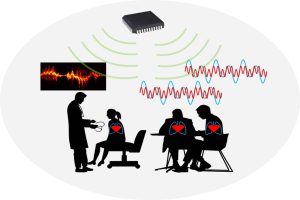
IEEE Transactions on Microwave Theory and Techniques
Special Issue on
Latest Advances on Radar-Based Physiological Sensors and Their Applications
Submission Deadline: November 18, 2024 November 30th 2024.
Publication Date: April 2025
Motivation
Contactless radar-based physiological sensors have become a topic of great interest in the last decade, enabled by recent hardware advances for automotive radar and next generation communications systems, and driven by a variety of healthcare, industrial, and security applications. Hardware advances include higher levels of transceiver integration with faster ADCs, more powerful processing, as well as integrated antennas and MIMO and beam steering capabilities. The need for unobtrusive monitoring is being driven by an aging population, higher levels of automation (IoT, UAV), development of smart environments, and NextG communications systems.
Automotive radar development has made millimeter-wave radar hardware readily available, operating in the ISM bands from 24 GHz to over 240 GHz, and including MIMO/beam steering capability. As automotive radar development grows to incorporate in-cabin monitoring, related hardware has become available for a number of other applications including perimeter security, vital signs health monitoring, occupancy sensing, and UAV-based monitoring. The emerging 6G communications standard will incorporate joint communication and sensing (JCAS), and more opportunities for radar sensing with communications signals to further drive advancement of physiological radar.
As technological development for physiological radar continues to grow, many fundamental questions remain: What is actually being measured? What are the optimum waveforms and operating frequencies for different applications? What are the fundamental limitations on radar sensitivity? What are the most useful metrics for assessing accuracy and benchmarking performance? What can be considered motion of interest and to what extent can it be isolated from extraneous motion?
This Special Issue solicits papers that report of the latest advancements in radar-based physiological sensors. Topics of interest include, but are not limited to:
- Fundamental questions such as those involving the physical origin of physiological radar signals, optimum waveform and operation frequency for specific applications, fundamental limits on radar sensitivity, and methods of benchmarking radar performance.
- Novel radar architectures and hardware advances such as those involving active and passive radar systems, harmonic radar, MIMO, and JCAS systems.
- Advances in demodulation and signal analysis including radar calibration, noise mitigation methods, data-based methods, and channel state information (CSI) signal processing.
- Emerging physiological radar applications in healthcare, smart environments, in-cabin monitoring and other IoT and UAV based applications.
Authors must consult the link https://mtt.org/publications/t-mtt/information-for-authors/ for submission instructions.
Guest Editors
Olga Boric-Lubecke
University of Hawaii at Manoa, Honolulu, USA
olgabl@hawaii.edu
Victor Lubecke
University of Hawaii at Manoa, Honolulu, USA
lubecke@hawaii.edu
Chung-Tse Michael Wu
Rutgers University, New Brunswick, USA
ctm.wu@rutgers.edu
Emanuele Cardillo
University of Messina, Messina, Italy
ecardillo@unime.it
Shekh Md. Mahmudul Islam
University of Dhaka, Dhaka, Bangladesh
mahmud@du.ac.bd